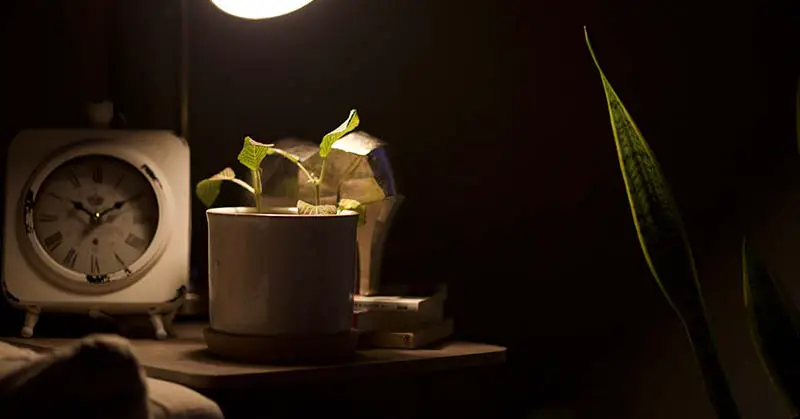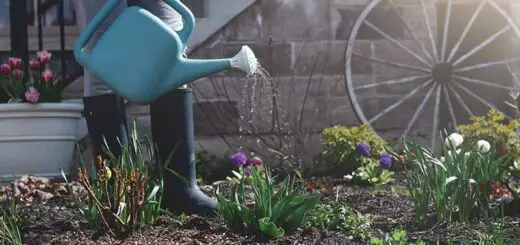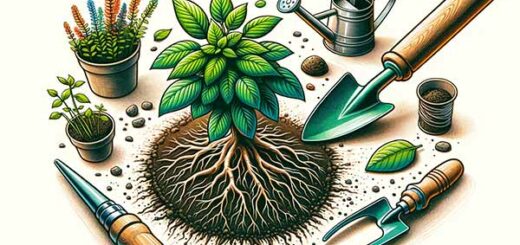How to Grow Plants for a Dark Room: Expert Advice
“Plants for a Dark Room” might seem impossible if you imagine sun-drenched meadows and leafy canopies. However, cultivating a lush indoor garden in spaces with little to no natural sunlight is both possible and remarkably rewarding.
This blog post aims to guide you through the exciting world of shade-loving plants, perfect for sprucing up those low-light corners in your home.
We’ll delve into understanding their unique light needs, explore our top picks that thrive in darker conditions, and provide comprehensive care tips to ensure your indoor garden flourishes.
Regardless of your gardening experience, this journey into low-light horticulture will equip you with the necessary knowledge to turn those dark, underutilized spaces into verdant, lively nooks teeming with green life.

Importance of Plants in Indoor Spaces
Indoor plants do more than enhance the aesthetic appeal of our homes. They play a critical role in creating a healthier and happier living environment. Let’s delve into why indoor plants are so important.
Improving Air Quality: Indoor plants purify the air by absorbing harmful pollutants such as benzene, formaldehyde, and trichloroethylene. This absorption process, coupled with their ability to release oxygen, helps to improve indoor air quality significantly.
Boosting Mood and Productivity: Being in the presence of plants can profoundly impact our mood and mental health. Studies suggest indoor plants can reduce stress, anxiety, and fatigue while enhancing mood, creativity, and productivity.
In addition, they can help create a calm and peaceful atmosphere, promoting feelings of relaxation and well-being.
Enhancing Humidity: Plants release moisture into the air, a process known as transpiration. This can increase indoor humidity, which is especially beneficial in dry climates or heated indoor environments, helping to prevent respiratory issues and dry skin.
Reducing Noise Levels: Believe it or not, indoor plants can also help absorb and deflect noise, reducing the overall noise levels and creating a quieter, more comfortable living or working space.
Providing Therapeutic Benefits: Even on a small indoor scale, gardening can be therapeutic. Caring for plants can provide a sense of purpose, reduce blood pressure, and promote well-being.
With all these benefits, it’s no surprise that incorporating plants into our indoor spaces has gained popularity. Whether it’s a dark room or a sunlit corner, there’s a plant suitable for every area.
Understanding how to choose and care for these plants is the first step to creating your indoor oasis.
The Challenge of Growing Plants in Dark Rooms
Growing plants in dark rooms can pose particular challenges, mostly stemming from the lack of natural light – an essential factor for photosynthesis, the process by which plants convert light energy into chemical energy to fuel their growth.
Reduced Photosynthesis: In darker rooms, the light available for photosynthesis is naturally lower, which can slow down a plant’s growth rate. This reduced light can lead to smaller leaves, slower growth, and in some cases, reduced flowering.
Poor Color and Form: Insufficient light can lead to etiolation, where plants grow tall and spindly as they stretch toward a light source. Foliage color can also fade or become less vibrant due to a lack of light.
Risk of Overwatering: Plants generally use water more slowly in lower light. This often leads to overwatering, leading to root rot and other fungal or bacterial diseases.
Limited Plant Selection: Not all plants are adapted to survive in low light conditions, limiting the types of plants that can thrive in darker rooms.
Despite these challenges, keep hope! Many plant species naturally adapt to understory environments with little direct sunlight, making them excellent candidates for darker rooms.
However, by choosing the right plants and caring for them properly, you can create a thriving green space even in the most shadowy corners of your home.
Understanding the Light Needs of Indoor Plants
Understanding indoor plants’ light needs is crucial to their survival and growth. Different plants have different light requirements, and these needs are typically categorized into three groups: low light, medium light, and high light. Here’s a brief explanation of each.
Low Light: Low-light plants can survive in areas with minimal natural light or in shadows. These plants are adapted to understory conditions, meaning they naturally grow under the canopy of larger plants and are accustomed to little direct sunlight.
However, low light doesn’t mean any light, so these plants still need indirect light to photosynthesize and grow. Examples of low-light plants include the Snake Plant and ZZ Plant.
Medium Light: Plants in this category prefer bright but indirect light. They should be placed in a well-lit room, but out of direct sunlight, as this can scorch their leaves. These plants enjoy light conditions similar to those found on the floor of a sunny forest.
Some examples are the Peace Lily and the Spider Plant.
High Light: High-light plants require several hours of direct sunlight each day. They’re typically found in sunny, open areas in the wild and are best suited to south-facing windows in the home. Too little light can result in slow growth and reduced vitality.
Examples include the Fiddle Leaf Fig and Aloe Vera.
It’s crucial to match your plants to the lighting conditions in your home and remember, these conditions can change throughout the day and across different seasons.
Understanding and catering to your plants’ light needs is one of the keys to successful indoor gardening.
Challenges of a Dark Room
Growing plants in a dark room is undeniably challenging but far from impossible. A “dark room” in plant care typically refers to a room that doesn’t receive much, if any, direct sunlight throughout the day.
This could be due to facing north (in the Northern Hemisphere), having small or no windows, or being significantly shaded by other buildings or trees outside. Here are some challenges specific to these conditions:
Limited Sunlight: The primary challenge with dark rooms is, of course, the lack of sunlight. Plants need light for photosynthesis, which they use to convert light into energy.
Without sufficient light, plants may grow slowly, develop weak stems, become elongated as they reach for the light, or lose the vibrancy of their leaf colors.
Temperature: Dark rooms can sometimes be cooler than the rest of your home, especially if they have little or no exposure to sunlight. Most indoor plants prefer temperatures between 60 and 75 degrees Fahrenheit (15 to 24 degrees Celsius).
If the temperature in a dark room falls below this range, it can slow plant growth and increase susceptibility to certain diseases.
Humidity: Low-light rooms can sometimes also have lower humidity, especially if they’re away from natural sources of moisture like bathrooms or kitchens. Many common houseplants come from tropical environments and may struggle in too-dry conditions.
Reduced Plant Variety: Not all plants can thrive in low light conditions so you might have a more limited selection of plants for dark rooms. However, there are still many beautiful, low-light-loving plants available.
Remember, every challenge presents an opportunity to learn and adapt. By understanding these potential obstacles and how to overcome them, you can transform a dark room into a thriving indoor garden.
The key is choosing the right plants and providing the best possible care.
What Makes a Plant Suitable for a Dark Room?
Several characteristics make certain plants more suitable for dark or low-light rooms than others. Here are a few key factors that enable these plants to thrive in less-than-ideal light conditions:
Natural Habitat: Many plants suitable for dark rooms originate from the understory of forests, where they are naturally adapted to lower light conditions. In these environments, they’ve evolved to survive beneath the canopy of larger plants that filter most of the sunlight.
Leaf Size and Color: Plants that thrive in low light often have larger, darker, or glossier leaves. The increased surface area and dark coloration allow the plant to absorb and utilize as much light as possible. Glossy leaves can also help reflect light to the lower parts of the plant.
Slow Growth Rate: Many low-light-tolerant plants have a slower growth rate. This adaptation allows them to conserve resources, requiring less energy from photosynthesis, which is beneficial in a darker environment.
Tolerance to Watering Mistakes: Plants in dark rooms use water more slowly, and it’s easy to overwater them. Many plants suitable for dark rooms are more tolerant of occasional overwatering or underwatering.
Resilience: Low-light plants are typically hardy and can endure less-than-ideal conditions, making them ideal for indoor spaces with limited sunlight.
Top 10 Plants for Dark Rooms
- Snake Plant (Sansevieria): This hardy plant can survive in various light conditions, including low light. Its tall, upright leaves with striking patterns add a touch of elegance to any room.
- ZZ Plant (Zamioculcas): ZZ plants are incredibly hardy and can withstand dark conditions. They have shiny, dark green leaves and are known for their drought tolerance.
- Pothos (Epipremnum aureum): Known for its trailing vines and heart-shaped leaves, pothos is an excellent choice for hanging baskets or high shelves in low-light rooms.
- Peace Lily (Spathiphyllum): Despite its preference for medium light, Peace Lilies can tolerate low-light conditions and bloom with beautiful white flowers.
- Cast Iron Plant (Aspidistra elatior): Living up to its name, it is nearly indestructible and can tolerate many conditions, including low light.
- Spider Plant (Chlorophytum comosum): Spider plants are easy to care for and can tolerate low light, though they prefer bright, indirect light.
- Dracaena (Dracaena spp.): There are several varieties of Dracaena, many of which can tolerate lower light conditions and are attractive additions to indoor spaces.
- Heartleaf Philodendron (Philodendron hederaceum): This plant is an excellent low-light option, known for its heart-shaped leaves and trailing growth.
- English Ivy (Hedera helix): English Ivy prefers bright light but can also adapt to low-light conditions, making it a flexible choice for darker rooms.
- Maidenhair Fern (Adiantum): While ferns generally prefer plenty of light, Maidenhair Fern can tolerate lower light levels and adds a delicate, feathery texture to your indoor garden.
Caring for Your Dark Room Plants
Like any other plants, those in a dark room need a certain level of care to stay healthy. So here are some key pointers for maintaining your dark room plants:
Watering: Be careful not to overwater plants in a dark room. These plants typically use less water due to lower light and photosynthesis levels. Wait until the top inch or so of the soil is dry before watering again. This could mean watering less frequently than you would for plants in a brighter space.
Light: Even low-light plants need some light. If a room gets no sunlight, consider using a grow light to provide the necessary light spectrum for photosynthesis. If there is some natural light, position plants where they can get the maximum benefit.
Temperature and Humidity: Most houseplants prefer temperatures between 60-75°F (15-24°C) and humidity levels around 40-60%. Keep plants away from drafts and heating or air conditioning vents, which can create sudden temperature changes.
Feeding: Plants in low light conditions typically grow slower and need less fertilizer. You might only need to feed them during the growing season (spring and summer) and less frequently in fall and winter. Always follow the instructions on your chosen plant food.
Pruning and Cleaning: Regularly prune your plants to remove dead leaves and promote bushier growth. Wiping the leaves gently with a damp cloth can help remove dust and allow the plant better absorb light.
Re-Potting: If your plant outgrows its pot or the nutrients in the soil have been depleted, it might be time to re-pot. Typically, plants should be re-potted every 12-18 months, but slower-growing plants in low-light conditions may only need it sometimes.
Troubleshooting Common Problems
Even with the best care, indoor plants can sometimes encounter problems. Here are some common issues and their possible solutions:
Yellow Leaves: This is often a sign of overwatering. Ensure your plant isn’t sitting in water and the pot has good drainage. Allow the soil to dry out a bit between waterings.
Brown Leaf Tips: This could indicate a lack of humidity. Try misting the plant, placing it on a tray of pebbles with water, or using a humidifier.
Leggy Growth or Small Leaves: This could indicate your plant isn’t getting enough light. Move it to a brighter location, or consider using a grow light.
Wilting or Dropping Leaves: This can signify underwatering and overwatering. Check the moisture level of the soil to determine the issue.
Slow Growth or Lack of Blooms: Slow growth is expected in low-light conditions. However, a lack of nutrients could also be a factor. Try feeding your plant with a balanced houseplant fertilizer.
Pests: Common houseplant pests include aphids, spider mites, and scale insects. Remove pests by wiping the leaves with a solution of mild dish soap and water, or use an appropriate insecticide.
Fungal Diseases: Overwatering and poor ventilation can lead to diseases like root rot or powdery mildew. Cut back on watering, increase air circulation, and remove affected parts of the plant.
Final Thoughts
While the lack of natural light in dark rooms can pose particular challenges, it’s far from an insurmountable barrier to cultivating a thriving indoor garden.
By selecting suitable plant species — naturally adapted to lower light conditions — and providing proper care, you can enjoy the benefits of indoor plants even in the most shadowy corners of your home.
The Snake Plant, ZZ Plant, Pothos, and others offer beautiful and resilient options for transforming your dark room into a lush green oasis.
Understanding your plants’ needs is the key to successful indoor gardening, even in low-light conditions. Be mindful of their water, temperature, and humidity requirements, and remember that while these plants are tolerant of low light, they still require some level of light to survive.
With patience, attentiveness, and a bit of green thumb ingenuity, your dark room can become a vibrant, life-filled space that not only boosts the aesthetic appeal of your home but also enhances your well-being.



